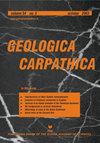Manín和Klape单元与Pieniny Klippen带和中西部喀尔巴阡山脉的联系:平衡歧义
IF 1.5
4区 地球科学
Q4 GEOSCIENCES, MULTIDISCIPLINARY
引用次数: 9
摘要
摘要本文研究了斯洛伐克西部皮宁-克里彭带经典地区的构造与演化。所谓的periklippen带是由侏罗纪至始新世奥拉维单位(Šariš, Subpieniny和Pieniny自下而上)建立的Pieniny Klippen带s.s到由三叠纪至中白垩世的Fatric和honic盖覆推覆体系组成的中西部喀尔巴阡山脉外缘的过渡。Peri-Klippen带在Váh中河谷中有相当宽的15公里,由Fatric Manín、Klape和Drietoma单元及其后的gosu型沉积盖层组成。所有这些单元都紧密地折叠和叠瓦。复杂的沉积和构造岩石记录表明,在晚Turonian期,锋面法特拉推覆体的侵位位置与内奥拉维奇元素相邻或上方,它们因此成为一个增生楔块的组成部分,以响应分隔喀尔巴阡山脉中西部和奥拉维奇域的南彭-瓦希大洋域的俯冲而发育。前陆奥拉维斯地区的楔顶坳陷与沟前深盆地的演化在楔顶动力学的控制下表现出密切的相互关系。褶皱和断裂构造的运动学和古应力分析表明,与增生楔发育同期,只有一个主导的应力系统,其特征是主压缩轴一般为北西-东向,在纯挤压-右挤压状态下运行,被与楔形塌陷阶段相关的短期伸展事件所中断。较年轻的中新世至第四纪古应力场与整个西喀尔巴阡山脉广泛记录的应力场相对应。根据区域构造地层学和构造资料,在更广泛的背景下讨论了Manín和Klape单元(可能与Fatric盖覆推覆体系有关)的古地理背景问题,以及发生在不同地层水平上的众多橄榄岩的来源问题。本文章由计算机程序翻译,如有差异,请以英文原文为准。
Linkage of the Manín and Klape units with the Pieniny Klippen Belt and Central Western Carpathians: balancing the ambiguity
Abstract The paper deals with the structure and evolution of the Pieniny Klippen Belt in its classic area in western Slovakia. The so-called Peri-Klippen Zone provides a transition from the Pieniny Klippen Belt s.s. built up by Jurassic to Eocene Oravic units (Šariš, Subpieniny and Pieniny from bottom to top) to the outer margin of the Central Western Carpathians composed of Triassic to mid-Cretaceous successions of the Fatric and Hronic cover nappe systems. The Peri-Klippen Zone attains a considerable width of 15 km in the Middle Váh River Valley, where it is composed of the supposedly Fatric Manín, Klape and Drietoma units, as well as their post-emplacement, Gosau-type sedimentary cover. All these units are tightly folded and imbricated. The complex sedimentary and structural rock records indicate the late Turonian emplacement of the frontal Fatric nappes in a position adjacent to or above the inner Oravic elements, whereby they became constituents of an accretionary wedge developing in response of subduction of the South Penninic– Vahic oceanic realm separating the Central Western Carpathians and the Oravic domain. Evolution of the wedge-top Gosau depressions and the trench-foredeep basins of the foreland Oravic area exhibit close mutual relationships controlled by the wedge dynamics. The kinematic and palaeostress analyses of fold and fault structures revealed only one dominating stress system coeval with development of the accretionary wedge, which is characterized by the generally NW–SE oriented main compression axis operating in a pure compressional to dextral transpressional regime, interrupted by short-term extensional events related to the wedge collapse stages. Younger, Miocene to Quaternary palaeostress fields correspond to those widely recorded in the entire Western Carpathians. Relying on the regional tectonostratigraphic and structural data, the problematic issues of the palaeogeographic settings of the Manín and Klape units, presumably affiliated with the Fatric cover nappe system, and of the provenance of numerous olistoliths occurring at different stratigraphic levels are then discussed in a broader context.
求助全文
通过发布文献求助,成功后即可免费获取论文全文。
去求助
来源期刊

Geologica Carpathica
地学-地球科学综合
CiteScore
2.40
自引率
23.10%
发文量
26
审稿时长
>12 weeks
期刊介绍:
GEOLOGICA CARPATHICA covers a wide spectrum of geological disciplines including geodynamics, tectonics and structural geology, volcanology, stratigraphy, geochronology and isotopic geology, karstology, geochemistry, mineralogy, petrology, lithology and sedimentology, paleogeography, paleoecology, paleobiology and paleontology, paleomagnetism, magnetostratigraphy and other branches of applied geophysics, economic and environmental geology, experimental and theoretical geoscientific studies. Geologica Carpathica , with its 60 year old tradition, presents high-quality research papers devoted to all aspects not only of the Alpine-Carpathian-Balkanian geoscience but also with adjacent regions originated from the Mediterranean Tethys and its continental foreland. Geologica Carpathica is an Official Journal of the Carpathian-Balkan Geological Association.
 求助内容:
求助内容: 应助结果提醒方式:
应助结果提醒方式:


